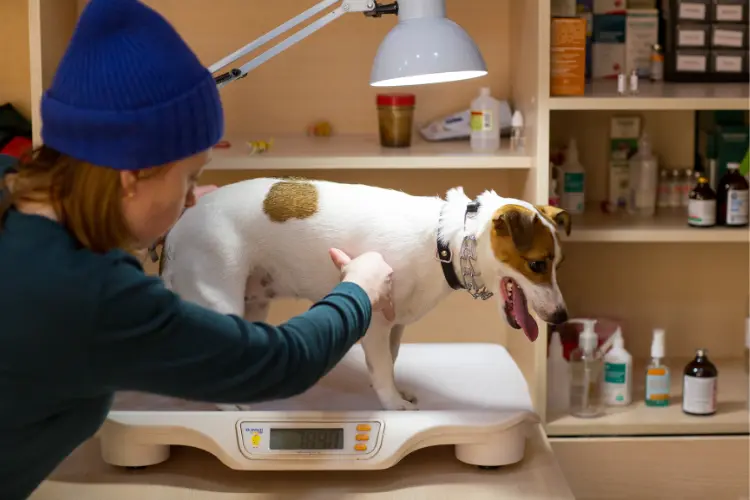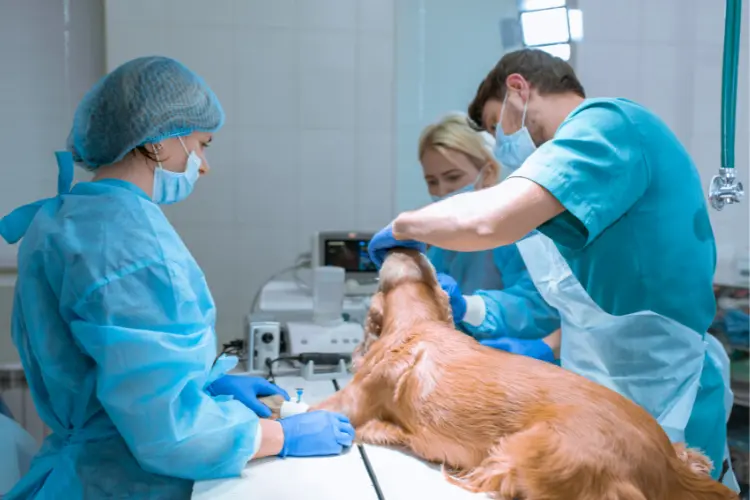How to Identify and Treat Insects That Bite Dogs
Imagine taking your beloved dog for a walk on a sunny summer day. Everything seems perfect until you notice your furry friend scratching incessantly. Insects that bite dogs have the potential to ruin a perfect day and, more importantly, cause serious health problems for your dog.
Don’t let these pesky pests disrupt your dog’s life! In this blog post, we’ll discuss how to identify and treat insect bites that affect dogs, covering common culprits, prevention strategies, treatment options, and recognizing allergic reactions.
Common Insect That Bites Dogs
Fleas
Fleas are tiny, dark brown insects that jump onto your dog’s body and feed on their blood, causing painful bites. These bites can lead to your dog scratching and chewing its body, resulting in skin trauma and scratches and sores on the dog’s skin.
Flea allergy dermatitis, a skin condition characterized by intense itchiness, hair loss, and sores due to self-trauma, is caused by an allergy to flea saliva.
To identify flea bites, look for small red spots on your dog’s skin, particularly on the lower back, tail, and hind legs. Keeping an eye out for flea dirt, tiny black flecks of fecal material and dried blood, can also help identify a flea infestation.
Prevention of flea infestations is critical for your dog’s well-being. Here are some tips to help prevent flea infestations:
- Avoid contact with animals that may carry fleas
- Use flea and tick-preventative products throughout the year
- Regularly inspect your dog’s coat for fleas and flea dirt to aid in early infestation detection, thereby minimizing discomfort for your pet.

Ticks
Ticks are eight-legged parasites that latch onto your dog’s body, usually on the legs or paws, and burrow into the skin to feed on their host’s blood. Species like the American Dog Tick, Brown Dog Tick, Deer Tick (Blacklegged Tick), and Lone Star Tick are known to bite dogs.
Tick bites can manifest as circular areas of inflamed skin that are red and somewhat swollen after a tick is removed or falls off.
To remove a tick from your dog, I recommend following these steps:
- Use a tick remover or tweezers.
- Press against the dog’s skin near the tick and slide the remover or tweezers under it.
- Carefully pull the tick free without jerking, squeezing, or twisting it.
After removal, dispose of the tick by placing it in a container filled with isopropyl alcohol.
A routine check-up for ticks on your dog, particularly after walks in wooded or grassy areas, can mitigate the risk of tick-borne diseases and contribute to your dog’s health.
Mosquitoes
Mosquito bites can cause red, raised skin lesions on your dog’s body, similar to those seen in humans. These bites are more likely to occur in areas with less fur, such as the ears, belly, inner legs, and groin region.
Mosquitoes not only cause discomfort for your dog but can also transmit heartworm disease, a serious and potentially fatal condition.
To protect your dog from mosquito bites, consider:
- Hiring a pest control company to spray your yard with mosquito repellent
- Applying pet-safe bug-repellent spray to your dog’s coat
- Using topical products like Advantix II and Vectra 3D for added protection against mosquitoes and other biting insects.
Consistent inspection of your dog for mosquito bites, coupled with heartworm prevention medication, can ensure your dog’s safety and comfort.
Ants
Ants, such as fire ants, carpenter ants, black garden ants, and red wood ants, can also bite dogs and cause discomfort.
To prevent fire ant bites, inspect your yard for ant hills and treat them if found. Keep your dog on a leash when walking or hiking to guide them away from ant hills. If ants are found on your dog’s body, take action immediately. Brush them off or if possible, rinse them off with water.
If multiple fire ants bite your dog, you should contact your veterinarian for advice on administering Benadryl and the appropriate dosage. Frequently checking your dog for ants and promptly removing them can ward off additional bites and discomfort.
Spiders
Spiders are arachnids that may bite dogs, with some species being potentially poisonous. Spider bites may appear as reddened, swollen, or raised areas on the skin, as well as possible discoloration or darkening.
Black widow and brown recluse spiders are two venomous species that dog owners should be particularly cautious of.
To protect your dog from spider bites, follow these steps:
- Maintain a clean and clutter-free environment to deter spiders from residing in your home or yard.
- Inspect your dog’s coat and skin for signs of spider bites frequently.
- Seek veterinary care if necessary. Prompt detection and treatment can help avert complications from venomous spider bites.
Preventing Insect Bites on Dogs
Having covered the common insects that bite dogs, it’s time to explore how to prevent these annoying pests from causing harm to your furry friend.
Three primary strategies can minimize the risk of insect bites on dogs: parasite prevention, environmental control, and regular grooming. Each strategy significantly contributes to safeguarding your dog’s health and happiness.

Parasite Prevention
Parasite prevention is vital for protecting your dog from insect bites and the diseases they can transmit. Some of the most effective forms of parasite prevention for dogs include using safe and efficacious parasite control products and medications.
Regular hand washing and maintaining good hygiene after contact with or cleaning up after your pets can also help prevent parasites.
For maximum protection, administer parasite prevention treatments to dogs four times a year alongside a broad-spectrum anthelmintic for intestinal parasites.
Also, provide flea preventatives monthly. Proactive parasite prevention can aid in maintaining your dog’s health and comfort.
Environmental Control
Environmental control involves managing the environment to minimize the presence of insects that may harm dogs. This can include:
- Utilizing vet-recommended flea and tick medication
- Maintaining a clean and dry environment
- Using water blasts
- Introducing predatory insects
- Utilizing traps
Another crucial aspect of environmental control is yard maintenance. Regularly mow your lawn and trim bushes to reduce hiding spots for insects.
Remove standing water, such as in birdbaths or flower pots, to prevent mosquito breeding grounds. Implementing these steps can create a safer habitat for your dog and lessen the likelihood of insect bites.
Regular Grooming
Regular grooming is essential for keeping insects away from dogs. Some grooming practices that can help reduce the risk of insect bites in dogs include:
- Removing and killing parasites
- Cleaning the coat
- Using flea shampoos
- Examining the body for pests
- Sanitizing the skin and fur
- Brushing
- Bathing
- Checking for ticks
- Trimming hair
- Using insect repellents
Mild symptoms from insect bites in dogs can generally be observed for a day or two and can be managed with basic first aid at home.
However, grooming your dog as frequently as possible, particularly if they have long fur, can help prevent insect bites and identify any existing parasites early. Regular grooming, besides keeping your dog looking and feeling great, prevents insect bites.

Treating Insect Bites on Dogs
Home Remedies
Several home remedies can help alleviate the discomfort caused by insect bites on dogs. Apple cider vinegar, lemon spray, and dog shampoos containing oat proteins, aloe, or tea tree oil can be effective home remedies for flea bites.
Planting pots of lemon balm, sage, rosemary, catnip, lemongrass, basil, and mint outside can also help repel fleas. For other insect bites, a baking soda paste made with water can be applied to the affected area to alleviate the bite and reduce redness and inflammation.
Aloe vera gel can be applied directly to mosquito bites to relieve cooling and promote healing. Essential oils, such as lavender, eucalyptus, and tea tree oil, can also reduce inflammation and itching caused by a mosquito bite.
A cold compress may be applied to the affected area to reduce swelling and discomfort. Monitoring your dog’s condition and seeking veterinarian consultation if the symptoms worsen or persist is vital.
Over-the-Counter Medications
Over-the-counter medications can also provide relief for insect bites on dogs. Hydrocortisone cream, antihistamines like diphenhydramine, and topical treatments such as aloe vera gel or calamine lotion are effective options for treating insect bites.
These medications can help reduce itching and inflammation caused by insect bites. Close monitoring of your dog’s condition and consulting with a veterinarian when needed, particularly if your dog exhibits severe symptoms or is bitten by a venomous insect, is essential.
Prior to administering any medication to your dog, consult with a veterinarian to ensure the medication is safe and appropriate for your pet.
Additionally, some over-the-counter medications, like diphenhydramine (Benadryl®), cetirizine (Zyrtec®), and loratadine (Claritin®), can be used to reduce allergic reactions associated with insect bites. Remember always to follow the recommended dosage and guidelines provided by your veterinarian.
Veterinary Intervention
In some cases, your dog may require veterinary intervention for insect bites. Signs that may necessitate veterinary intervention include:
- pronounced swelling around the head and neck
- indications of anaphylaxis or a severe allergic reaction
- substantial swelling
- vomiting
- diarrhea
- debility
- collapse
- tremors
- copious drooling
- restlessness
- intense itching in one location
- indications of pain in one area
- pale gums or other indications of distress
If your dog exhibits any of these symptoms, contact your veterinarian immediately.
Veterinary treatment for insect bites, including how to treat bug bites, may involve:
- Routine cleanings
- Bandages
- Cold compresses to alleviate pain and swelling
- Antibiotics may be prescribed to prevent infection
It’s crucial to keep a close eye on your dog’s condition and follow the advice of your veterinarian to ensure a speedy recovery.

Recognizing Allergic Reactions in Dogs
Mild Symptoms
Mild allergic reactions to insect bites in dogs may include:
- localized swelling
- itching
- mild rash
- obsessive licking
These symptoms may be observed for a day or two and can often be managed with basic first aid at home. Nonetheless, closely monitoring your dog’s condition and consulting with a veterinarian if the symptoms intensify or persist is crucial.
Moreover, dog owners should familiarize themselves with the visible signs of a mild allergic reaction, such as:
- Redness, swelling, and itching at the site of the bite
- Hives or multiple red, raised swellings across the body
- A swollen face or muzzle
- Difficulty breathing
- Vomiting
By recognizing these symptoms early, you can provide prompt care for your dog and prevent complications.
Severe Symptoms
Severe allergic reactions to insect bites, including bee stings, in dogs can include:
- Hives
- Difficulty breathing
- Facial swelling
- Vomiting
- Diarrhea
- Weakness
- Collapsing
- Seizures
- Anaphylactic reactions
These symptoms may indicate a serious allergic reaction that requires immediate veterinary attention.
If a severe allergic reaction occurs, prompt contact with a veterinarian and adherence to their advice on emergency treatment is imperative.
This may include administering antihistamines or other treatments to alleviate symptoms and prevent further complications. Early recognition and intervention can help ensure your dog’s safety and well-being.
Emergency Treatment
If your dog experiences a severe allergic reaction to an insect bite, time is of the essence. The first steps of emergency treatment include:
- Removing the source of the allergen
- Rinsing the pet’s skin if the reaction is due to topical exposure
- Seeking prompt veterinary attention if there is difficulty breathing or swelling in the face, neck, or throat.
Your veterinarian may recommend administering oral antihistamines, such as Benadryl, to help reduce the severity of the allergic reaction. It’s crucial to follow your veterinarian’s advice on the appropriate dosage and administration of any medications.
Acting swiftly and seeking professional assistance can aid in your dog’s recovery from a severe allergic reaction and ward off life-threatening complications.
Read also: Puppy Training Timeline: When to Start Training a Puppy
Frequently Asked Questions
How do you know if my dog was bitten by a bug?
Look for signs of redness, swelling, a puncture mark, or excessive scratching on your dog’s skin. Monitor the symptoms closely, as their severity can help you determine whether a vet visit is necessary.
What are the black bugs biting my dog?
Your dog is likely being bitten by female horseflies or deer flies, which are members of the Tabanidae family in the order Diptera. The stings from these pesky insects aren’t typically severe, but they can cause discomfort and should be treated if symptoms persist.
Can I use human insect repellent on my dog?
No, it is not recommended to use human insect repellent on dogs. Instead, use pet-safe products designed specifically for them.
Can I give my dog Benadryl for an insect bite?
It is possible to give Benadryl to your dog for an insect bite, but it is important to consult your veterinarian for appropriate dosage and instructions.
How can I prevent my dog from getting bitten by mosquitoes?
Protect your dog from mosquito bites by using pet-safe bug repellent sprays, topical products such as Advantix II and Vectra 3D, or hiring a pest control company to spray your yard with mosquito repellent.
Summary
Insect bites can cause discomfort and even severe health problems for your dog. By understanding common culprits, implementing prevention strategies, and recognizing and treating allergic reactions, you can help keep your furry friend happy and healthy.
Remember, early detection and intervention are key to ensuring your dog’s well-being. Stay vigilant, and don’t hesitate to consult a veterinarian if you have concerns about your dog’s health.




